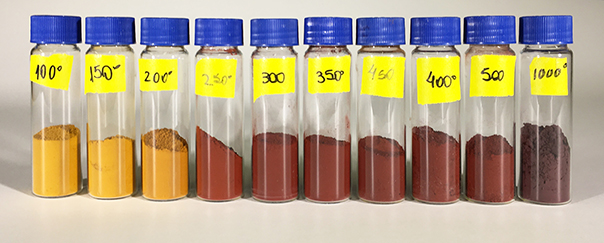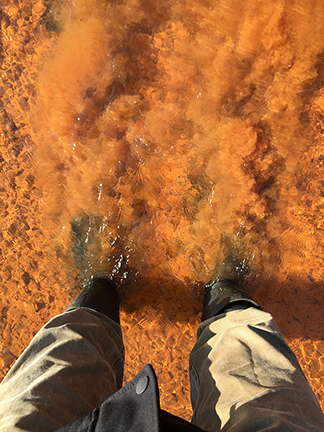Posted by Curry S. on Jan 28th 2020
Toxic Art: Turning Pollution into Paint with John Sabraw
With Earth Day right around the corner, we thought it was the perfect time to introduce you to John Sabraw. John has a long resume including professor, environmentalist, and artist. Read below to learn more about the incredible work John is doing to clean polluted streams and create amazing art in the process. If you're inspired by Johns work, we urge you to join us in donating to his Kickstarter, Toxic Art: Turning Pollution into Paint.
Artist & Craftsman Supply: Science and art aren’t two things people would necessarily think of as a pair. What was it that first brought them together for you?
John Sabraw: Ah, but they should think of them as a pair! Artists and scientists have a common curiosity about our universe and a drive to share what we discover with our fellow humans. I’ve always been an inventor/artist and most artists I’ve met are. Thinking back though, when I was just becoming a teen I was in a lot of trouble and I was given a choice – juvenile correction or counseling. I chose counseling. It was an unusual kind of counseling. I was required to go to weekly meetings with a chemistry professor at the local university, so I could learn about the true dangers of my own … experiments.

Toasted line of test tubes
Fortunately, Dr. Carl Bricker could tell I was just trying to find a way to mark my existence, a way to matter. So, he told me about black holes and infinity, quantum entanglement, and relativity – fundamental questions about our place in the universe still drive my work today. It was a scientist who helped me become an artist.
A&C: What's the craziest thing that has happened to you while out collecting toxins?
JS: Love this one! So, these seeps of acid mine drainage (AMD) are very sketchy; just last month I was with photographer Ben Siegel, we were skirting a huge swamp of AMD near Oreton wearing muck boots that go up just below our knees because we weren’t planning on going into the swamp area, so we didn’t need waders. All of the ground around is covered with dead leaves as it’s the end of winter. Suddenly the leaves give way and Ben and I plunge to our waste in smelly, slimy AMD sludge and it is nearly like quicksand, we managed to slowly crawl out and somehow keep our boots too, but the AMD completely filled our boots all the way to the toes. We still had to hike out of there with all our gear squishing AMD in our boots the whole time. It was like 3 days straight of washing to get most of the sludge out and my hands and feet were orange for days.

AMD Seep | Sunday Creek in Corning, Ohio
A&C: Tell us about the process of building the pilot plant for processing acid mine drainage.
JS: It’s been years of work by many people to get our process ready to test at scale in a pilot plant. We have taken all of those metrics and scaled them up to handle thousands of gallons of water instead of just a 5-gallon bucket in the lab. We received a grant from the Sugar Bush Foundation for the structure of the plant last summer. We’ve had 20 AmeriCorps and other volunteers help us construct three big concrete pads that can handle the weight of the water in the three main settling tanks. The tanks have been built and are ready to install which will happen any day now. Then we will build a tower that will have a pump to bring AMD up from the seep into three colander type trays that will aerate the water and drop it into the first tank, then we’ll connect all the tanks to each other and to the final stage, which is a slag bed that will set the final pH as the clean water returns to the stream.
We have to enclose the plant for safety, so that is what this Kickstarter is for: making an enclosure that is also an immersive, educational ‘art wall’ that will tell the story of this clean up method, the history of how this pollution started, and the history of Corning, OH where it is located. My team of 25 students has been developing plans and designs after meeting with many people and we hope to have a final design by the end of April and begin construction immediately thereafter.

Pilot Plant and proposed art wall enclosure
A&C: Have you seen a difference in the pigments you’ve collected over the years?
JS: Oh, for sure! The interesting thing is that each AMD seep has its own unique chemical properties. Therefore, the pigments we extract also have very different characteristics. For example: Two major mine seeps: Corning, and Bat Gate, are within a 12-minute drive from each other, but the initial pigments extracted are very different, one being initially redder and more brittle, and the other being more orange and fluffy. In the lab, as our process evolved, the pigments have gone from boring, smelly brown dirt – to bright, clean and deeply inspiring hues.

Bat Gate Cave AMD Seep | Sulfer Springs, Ohio
A&C: Have you collected “toxic” pigments anywhere other than Ohio?
JS: “Toxic” pigments no, but that may change soon.
A&C: Does climate have anything to do with changes in these pigments?
JS: Temperature, oxygenation rates, sunshine, and bacteria all affect how the pigments crystalize, so climate definitely changes them.

Left: Toxic Sludge in a jar
Right: AMD Sludge & Gamblin Oil Paint

